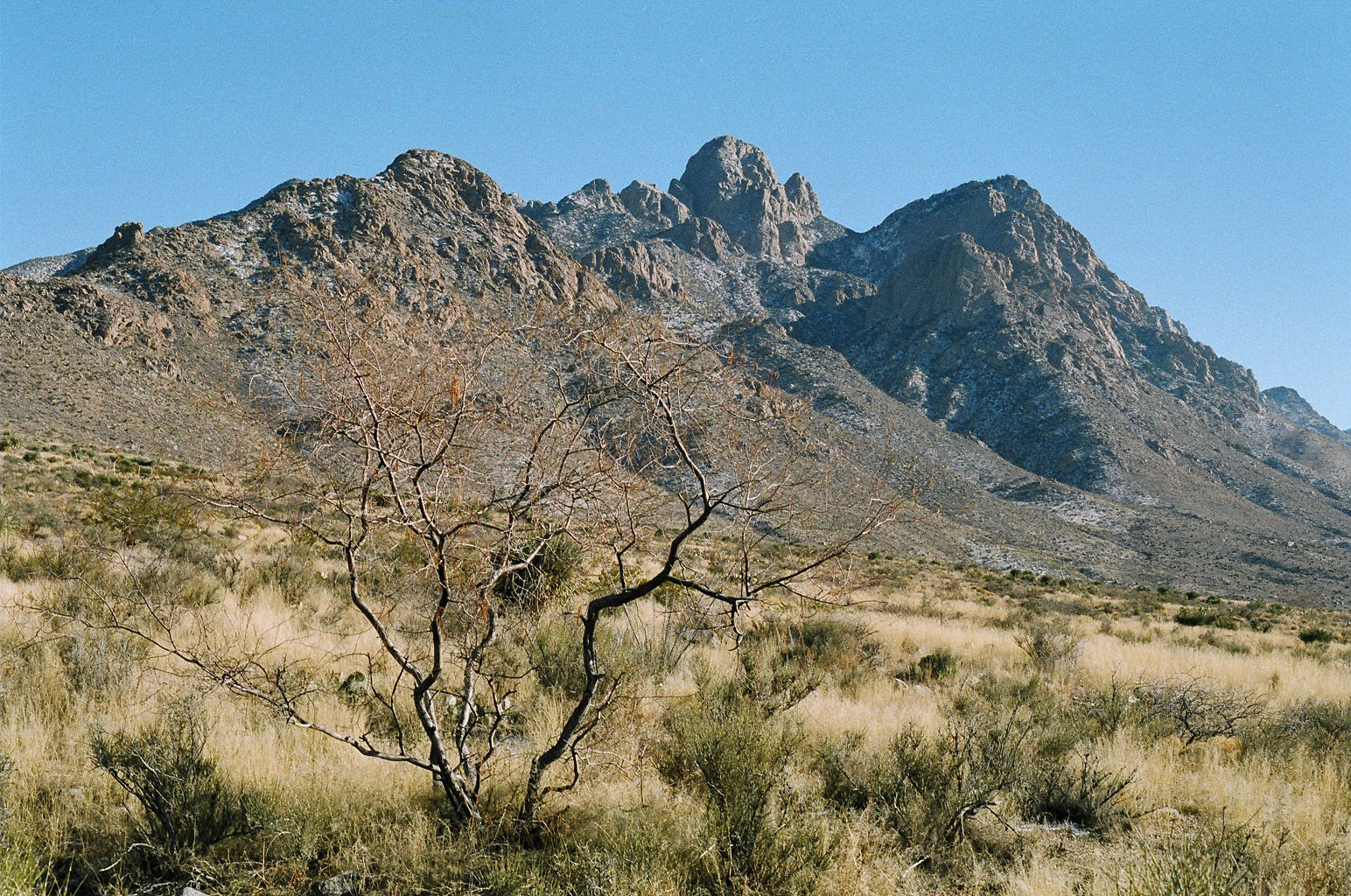
|
DESERTS by David B. Richman, Mesilla Park, New Mexico, USA. |
I grew up in a desert and was a “desert rat” from the age of six, when my parents took me out into its vast reaches of rock and sand. I was soon at home in the blistering heat and quickly learned the cardinal rules—always wear a hat, always wear long sleeved shirts (we had no sun screen back then), always carry water, be aware of your surroundings, watch for rattlesnakes and range bulls, and always be sure of your footing. The desert is not kind to those who fail to obey these strictures.
Deserts are defined as very dry areas with usually less than 25-30 or so cm of rain a year. They are generally without large trees and are often sandy, graveled with desert pavement (smooth stones), or very mountainous and rocky. Usually all of these habitats can be found in any sizable desert. About a fifth of the world’s land masses fit this definition, but the surrounding dry lands that receive somewhat more rain, but not usually enough for farming, add another fifth. Thus somewhere around 40% of the earth’s surface is composed of dry lands, including desert, desert grassland and semi-desert scrub, and in some areas the bordering scrub lands are expanding under stress of over grazing and global climate change. True deserts are scattered around the earth in uneven clumps. The word is exemplified by the largest of these, the Sahara, whose very name means “desert.” Other deserts include the Great Basin, Sonoran, Chihuahuan and Mojave of North America, the Atacama Desert of South America, the Kalahari and Karoo of South Africa, the Taklamakan of China, the Gobi of Mongolia, the Kara Kum of the Aral Sea region and of course the vast deserts of Australia.

The Organ Mountains of New Mexico in winter. This is the relatively lush Chihuahuan Desert grassland of New Mexico.
The desert where I grew up was the comparatively hyperarid Sonoran Desert near Yuma, Arizona. By this I mean that we had less than 75 mm of rain a year on average. Occasionally we would get rains from Pacific hurricanes or other storms, but we usually did not get the “monsoon” rains known in the eastern Sonoran and much of the Chihuahuan Deserts. The winter “Californian” rains were uncommon, but did happen occasionally.
Yuma is in the western Sonoran Desert and is also in a river valley—the lower valley of the Colorado River, far south of its spectacular cut through the Grand Canyon. At near San Luis Rio Colorado, Sonora, the river was dry at least by the time I was in my early 20s. North of San Luis, Morales Dam siphoned off the last of the water for use in the irrigation of the Mexicali Valley in Baja California.
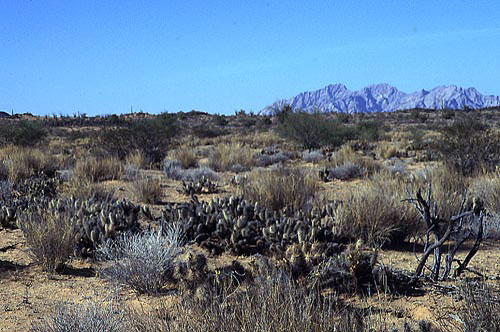
The Tule Desert along the Camino del Diablo. Such hyper-dry areas of the Sonoran Desert are still full of life, but the cacti have the longest spines that I have seen.
Still, despite the lack of water, the Yuma section of the Sonora Desert was anything but dead. It was part of the so-called succulent desert in which the dominant plants are often huge cacti like the saguaro or (in Baja California and southern Sonora) the cardon. Strange and often twisted and gnarled trees like the palo verde, iron wood, mesquite and elephant trees could be found there and the generally smaller smoke tree with its bluish flowers (making it look like a puff of smoke on the distance) joined equally unusual shrubs, like the ocotillo and the various yuccas and agaves. In addition there was an almost bewildering variety of cacti smaller than either saguaro or cardon. Thus a space craft landing in even this hyperarid desert would immediately detect living matter with just its cameras. There is a great difference between this and the deserts of Mars.
Deserts are indeed quite lively on this planet, with the more Mars-like Atacama Desert in South America having spiders and some insects even in places that lack as much as a sprig of green plant life. Some parts of the Mojave, Sonoran, Negev, Sahara, Kalahari and other deserts can in fact look like Martian deserts in at least some parts, but still life can be found there with relatively little effort. The life that is found in such situations is often quite specialized for survival in dry areas. Snakes like the sidewinder rattlesnake in the United States and the sand vipers (at least two genera) in Africa have evolved a side-winding motion to travel on sandy surfaces, as in dunes. Many desert animals, such as kangaroo rats in North America and jerboas in North Africa, have evolved the ability to extract water from their food. Indeed water is a precious and important commodity in the desert, as is demonstrated by the lushness of plants and the diversity of other organisms at and in the occasional natural water tanks (tinajas in the Southwest and Mexico) and springs (as in the Ojito Adentro spring at Big Bend Ranch State Park in the Chihuahuan Desert of Texas).
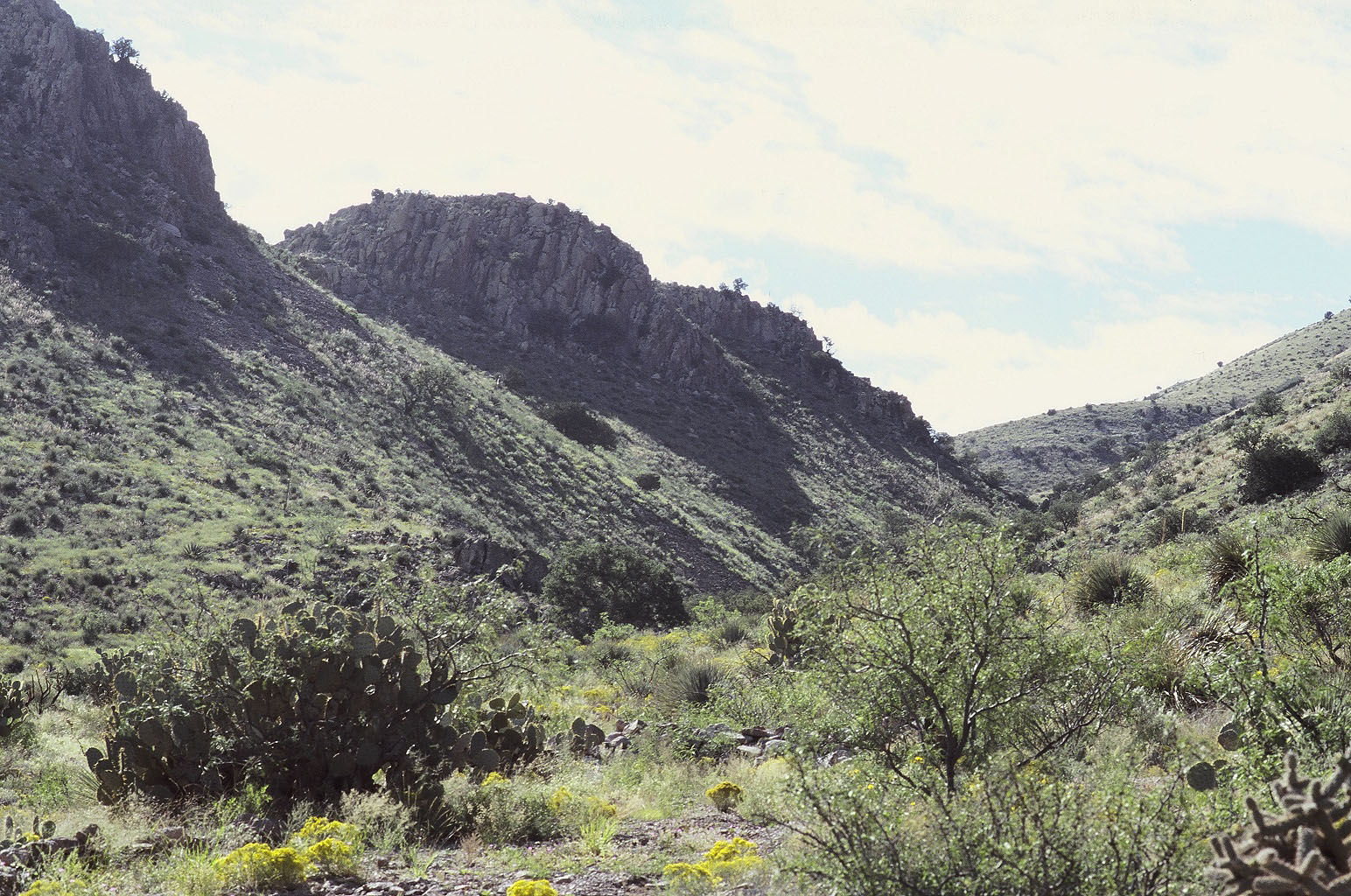
Owl Canyon in the Peloncillo Mountains, one of the Sky Islands along the Mexican border. Note the result of heavy rains a few weeks before the photo was taken.
Deserts have shaped human history. For centuries the Sahara was mysterious and a major barrier to colonialists. Mussolini planned a paved road across its vastness. The Desert Fox, Erwin Rommel, was driven back on its northern edge during World War II. Even before this the Romans found it more than a match for their legions. Deserts were so feared that it never occurred to the Khwarezmid Shah that one part of Ghinghis Khan’s army could cross the Kara Kum Desert and attack him, but the stalwart Mongols performed this then unimaginable feat! The Taklamakan Desert of China has such a bad reputation that it is known as the “Desert of Death” (a rough translation of its name). In recent times this desert has been crossed by a woman alone. In another extraordinary feat the Greek Xenophon retreated with his army of mercenaries from Persia across the Middle Eastern deserts back to Greece. But the Sahara was a different story. Even now its sandy and rocky reaches are relatively little frequented, except by the very hardy nomads who have lived there for centuries. Ironically, only a short time ago (geologically speaking) the Sahara was lush.
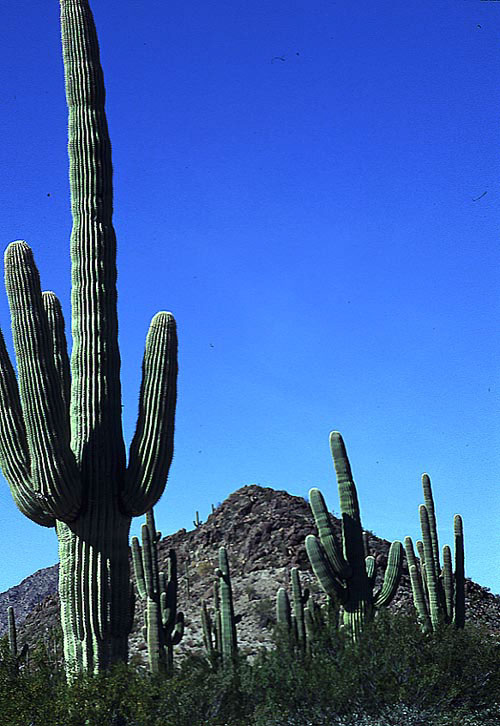
Giant cacti (saguaros) along the Camino del Diablo (Sonoran Desert) in Yuma County, Arizona.
By comparison to much of the modern Sahara my home desert near Yuma was a verdant land. Still many people have died trying to cross its Mexican-United States border trail, known as the Camino del Diablo, especially during the Gold Rush and later movements of people to the west. Today the Sonoran and also the Chihuahuan Deserts’ victims are more likely to be illegal immigrants, trying to find work in the United States. The dryness of the desert is a trap for the unwary and the victims of the “Coyotes” who “guide” them across the border for a fee. After death by dehydration and heat stroke, the next most common way to die in the desert is by drowning! The fierce summer thunderstorms can easily catch the traveler unaware, as one did recently near Tucson, Arizona. One person died and a number of others just escaped as a wall of water roared down Sabino Canyon in the Santa Catalina Mountains.
Like most deserts, the Sonoran Desert was created by a rain shadow, in this case cast by the coast ranges of California. Pacific storms tend to dump their moisture in these high mountains, leaving the land beyond them parched. Global warming will certainly play a role in the future of deserts, but the exact nature of that change depends on local conditions and cannot yet be accurately predicted.
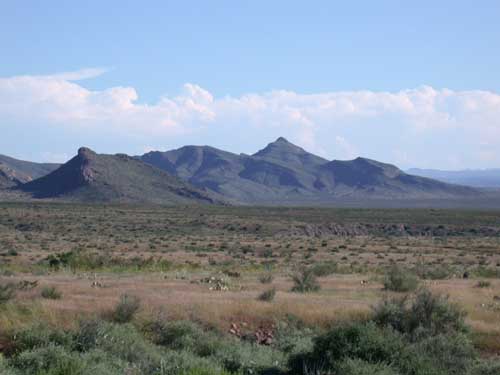
Bishops Cap, a primarily sedimentary mountain, south of the igneous peaks of the Organ Mountains in New Mexico’s Chihuahuan Desert.
Despite the difficulties (or perhaps because of them) deserts in North America especially are centers of biodiversity. This is in part because of the numerous micro-habitats (such as Ojito Adentro, Tinajas Altas along the Camino del Diablo, Bitter Lake near Roswell, New Mexico, and Quitobiquito Spring in Organ Pipe Cactus National Monument in Arizona.) They also gets more rain (up to 250 plus mm/year) than many truly hyperarid regions (in some parts of the Atacama Desert it has not rained in years!) In addition the “Mountain Islands” of southeastern Arizona and southwestern New Mexico act as rain-catchers and, often rising to near 3000 m, they actually support mountain conifer forests, as well as tracts of Madrean oak forest in their lower foothills and canyons. In the Peloncillo Mountains the Madrean forest is extensive enough to be home for occasional wandering jaguars, as well as javilena, coati mundi, trogons, hummingbirds and rattlesnakes, among a host of other creatures. In some areas rain is not the main source of water. In southern Baja California’s Magdalena Plains lush plant growth is promoted by Pacific Ocean fogs rather than rains. It seemed odd to me to see epiphytic ball moss (actually a bromeliad related to pineapples) growing quite nicely on cardon cacti there.
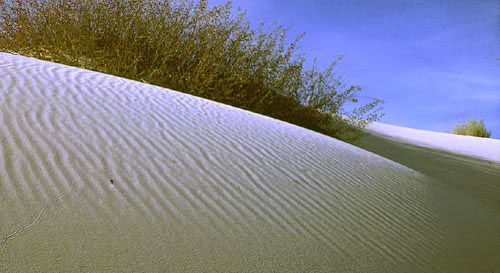
White Sands National Monument in the Chihuahuan Desert. These gypsum
sands are wet compared to the silicate sands in the
Sonoran Desert
and areas of the dunes may flood in heavy rains.
Perhaps the most neglected life forms found in the deserts (and in many other habitats) are the microorganisms. Certainly everywhere I have sampled in the southwestern United States some forms of microscopic life are present. In some cases, as in spring runoff from the Organ Mountains or the saline waters of Bitter Lake, the microscopic life is phenomenal. In streams of the “mountain Islands”, like the Chiricahuas in Southeast Arizona, the samples can be full of desmids, ciliates and rotifers, while runoff from the Organ Mountains can contain desmids or diatoms in profusion. Any temporary rain catchment is soon colonized by algae of one sort or another. In addition, desert soils often are covered with cyanobacterial crusts and the rocks are often are hosts to crustose lichens and other “lower“ organisms which reward microscopic examination. We know relatively little about the microorganisms of such habitats. Indeed, as I have found over the years we know little about many biological entities that live in deserts and their associated mountains. I even have an undescribed species of tarantula from the Peloncillo Mountain range!
I camped a few years ago, along with several companions, at Tule Well on the Camino del Diablo. Looking up at the sky I saw the stars so thick that I literally had difficulty finding the constellations. The desert was palpably silent. The silence was almost unnerving and it made me strain to hear faint sounds, so used am I to the constant rumble of traffic. Still, I was glad to be there in that silence, surrounded by the ghostly shapes of saguaro, ironwood, elephant tree and palo verde. It was food for the psyche, for want of a better word. Similar thoughts filled my mind at a camp in the Sierra de la Giganta of Baja California Sur, but in this case the silence was broken by the distant sound of a poor-will, a relative of the nighthawk, whose plaintive call echoed down the wild canyons.
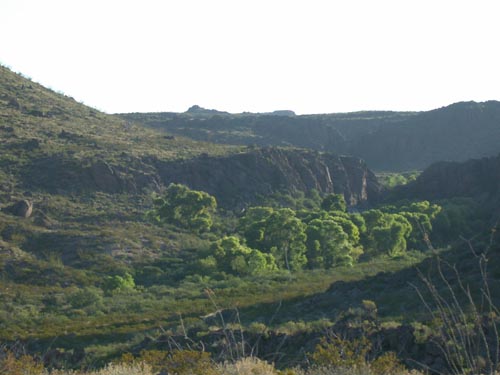
Ojito Adentro in the Big Bend of Texas. An oasis in the Chihuahuan Desert that boasts a waterfall and maidenhair ferns, as well as poison oak and grape vines!
We should cherish our deserts, as we should cherish our rain forests, out boreal forests, our grassland or our lakes, rivers and seas. They all make up this remarkable planet on which we live. The billions of years that have passed since our planet was formed from the rubble of the early solar system have produced in earthly habitats a complex weave of living landscape and diverse organisms. If we saw such places for the first time on some alien planet they would astound us. On earth they all too often suffer from their familiarity. Deserts especially were and still are frequently denigrated as “wastelands” (as the forests were uninhabited and scary and swamps were “green hells.”) However, among Earth’s many nooks and crannies deserts stand out as unique sources of biotic diversity as well as inspiring destinations. Indeed, our deserts contain more than we know and perhaps much more than we can know.
Comments to the author, David Richman, are welcomed.
REFERENCES
Cloudsley-Thompson, J. L. 1984. Sahara Desert. Pergamon Press, Oxford, England. A more technical summary of what was known about the ecology of the great desert.
Cloudsley-Thompson, J. L., and M. J. Chadwick. 1964. Life in Deserts. Dufour Editions, Philadelphia, PA. An old standby, but still of great interest.
Crawford, C. S. 1981. The Biology of Desert Invertebrates. Springer-Verlag, Berlin. The best survey of desert invertebrates - unfortunately long out of print.
Gehlback, F. R. 1981. Mountain Islands and Desert Seas: A Natural History of the U. S. - Mexican Borderlands. Texas A & M Press, College Station. A very interesting look at the U. S. - Mexican Borderlands.
George, U. 1977. In the Deserts of This Earth. Harcourt Brace Jovanovich, New York. A very readable account of the world deserts.
Hartman, W. K. 1989. Desert Heart: Chronicles of the Sonoran Desert. Fisher Books, Tucson, AZ. A wonderful well illustrated tour of the history, geology and places in the Pinacate and along the Camino del Diablo.
Jaeger, E. C. 1957. The North American Deserts. Stanford University Press, Stanford, California. Again a bit dated, but with nice maps.
Larson, P., with L. Larson. 1977. A Sierra Club Naturalist’s Guide to the Deserts of the Southwest. Sierra Club Books, San Francisco, California. Packed with information about the Southwest Deserts, the physical aspects, flora and fauna.
Phillips, S. J. and P. W. Comus (eds.) 2000. A Natural History of the Sonoran Desert. University of California Press, Berkeley. A more up to date treatment of the desert where I grew up!
Swift, J. 1975. The Sahara. The World’s Wild Places. Time/Life Books, Amsterdam. The best general book on the Sahara that I have found!
Tweit, S. J. 1995. Barren, Wild and Worthless: Living in the Chihuahuan Desert. University of New Mexico Press, Albuquerque. A personal account of my current home desert by a good friend of mine.
Other references can be found on the Internet in articles from Wikipedia, the Encyclopedia Britannica and other sources, such as historical books on Ghinghis Khan and the Roman Empire. Unfortunately there are few references on the microbiota of the deserts.
All photos are by David B. Richman.
Microscopy UK Front Page
Micscape Magazine
Article Library
Please report any Web problems or offer general comments to the Micscape Editor.
Micscape is the on-line monthly magazine of the Microscopy UK web site at Microscopy-UK.